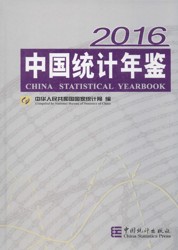一、《中国统计年鉴—2016》系统收录了全国和各省、自治区、直辖市2015年经济、社会各方面的统计数据,以及多个重要历史年份和近年全国主要统计数据,是一部全面反映中华人民共和国经济和社会发展情况的资料性年刊。
二、本年鉴正文内容分为27个篇章,即:1.综合;2.人口;3.国民经济核算;4.就业和工资;5.价格;6.人民生活;7.财政;8.资源和环境;9.能源;10.固定资产投资;11.对外经济贸易;12.农业;13.工业;14.建筑业;15.批发和零售业;16.运输、邮电和软件业;17.住宿、餐饮业和旅游;18.金融业;19.房地产;20.科学技术;21.教育;22.卫生和社会服务;23.文化和体育;24.公共管理、社会保障和社会组织;25.城市、农村和区域发展;26.香港特别行政区主要社会经济指标;27.澳门特别行政区主要社会经济指标;同时附录两个篇章:台湾省主要社会经济指标;国际主要社会经济指标。
为方便读者使用,各篇章前设有《简要说明》,对本篇章的主要内容、资料来源、统计范围、统计方法以及历史变动情况予以简要概述。篇末附有《主要统计指标解释》。
三、本年鉴所涉及的全国性统计数据,除行政区划、土地面积和森林资源及特殊注明外,均未包括香港、澳门特别行政区和台湾省数据。根据中华人民共和国“香港特别行政区基本法”和“澳门特别行政区基本法”的有关原则,香港、澳门与内地是相对独立的统计区域,依据各自不同的统计制度和法律规定,独立进行统计工作,本年鉴中有关统计资料分别由香港特别行政区政府统计处、澳门特别行政区政府统计暨普查局提供,国家统计局进行编辑。
四、本年鉴所涉及东部、中部、西部和东北地区的具体划分为:
东部地区:有10个省(市),包括北京、天津、河北、上海、江苏、浙江、福建、山东、广东和海南。
中部地区:有6个省,包括山西、安徽、江西、河南、湖北和湖南。
西部地区:有12个省(区、市),包括内蒙古、广西、重庆、四川、贵州、云南、西藏、陕西、甘肃、青海、宁夏和新疆。
东北地区:有3个省,包括辽宁、吉林和黑龙江。
五、本年鉴所使用的度量衡单位均采用国际统一标准计量单位,并统一使用最新颁布实施的产品目录。
六、本年鉴中涉及到的历史数据,均以最新出版的本年鉴数据为准;本年鉴中部分数据合计数或相对数由于单位取舍不同而产生的计算误差,均未做机械调整。
七、符号使用说明:年鉴各表中的“空格”表示该项统计指标数据不详或无该项数据;“#”表示其中的主要项;“*”或“1”表示本表下有注解。香港及澳门部分的符号使用方法具体见其篇章说明。
八、与2015年版《中国统计年鉴》相比较,本年鉴在篇章结构和内容上主要做了如下修订:将“房地产”部分调整至“金融业”之后,将“运输、邮电和软件业”调整至“住宿、餐饮业和旅游”之前;“人口”中新增平均人口预期寿命表;“国民经济核算”中,根据研发支出核算方法改革方案,对各年度GDP数据进行了系统修订。“价格”中按工业行业分工业生产者出厂价格指数表采用2011年版的行业分类标准;“工业”中适当扩充反映规模以上工业企业经济运行的基础性指标。根据最新的统计报表制度,对铁路等专业统计内容及相关统计指标进行了调整。
I.China Statistical Yearbook 2016 is an annual statistical publication,which reflects comprehensively the economic and socialdevelopment of China.It covers data for 2015 and key statistical data in recent years and some historically important years at thenational level and the local levels of province,autonomous region and municipality directly under the Central Government.
II.The Yearbook contains twenty-seven chapters:l.General Survey;2.Population;3.National Accounts;4.Employment andWages;5.Prices;6.People’s Living Conditions;7.Government Finance;8.Resources and Environment;9.Energy;10.Investmentin Fixed Assets;11.Foreign Trade and Economic Cooperation;12.Agriculture;13.Industry;14.Construction;15.Wholesale andRetail Trades;16.Transport,Postal and Telecommunication Services,and Software Industry;17.Hotels,Catering Services andTourism;18.Financial Intermediation;19.Real Estate;20.Science and Technology;21.Education;22.Public Health and SocialServices;23.Culture and Sports;24.Public Management,Social Security and Social Organizations;25.Urban,Rural and RegionalDevelopment;26.Main Social and Economic Indicators of Hong Kong Special Administrative Region(SAR);27.Main Social andEconomic Indicators of Macao Special Administrative Region(SAR).Two chapters listed as Appendices are Main Social andEconomic Indicators of Taiwan Province and Main Social and Economic Indicators of Other Countries/Regions.
To facilitate readers,the Brief Introduction at the beginning of each chapter provides a summary of the main contents of thechapter,data sources,statistical scope,statistical methods and historical changes.At the end of each chapter,Explanatory Notes onMain Statistical Indicators are included.
III.The national data in this book do not include those of the Hong Kong Special Administrative Region,the Macao SpecialAdministrative Region and Taiwan Province,except for the divisions of administrative areas,the area of the national territory andforest resources and otherwise specified.In accordance with the principles set down in the Basic Law of Hong Kong SpecialAdministrative Region,and the Basic Law of Macao Special Administrative Region,statistically Hong Kong,Macao and themainland of China are three mutually independent regions,each following its own and different statistical systems and legalprovisions in conducting statistical operations independently.Statistics on the Hong Kong Special Administrative Region and theMacao Special Administrative Region as included in this yearbook are provided by the Census and Statistics Department of theGovernment of Hong Kong Special Administrative Region and the Statistics and Census Service of the Government of MacaoSpecial Administrative Region respectively;and are edited by the National Bureau of Statistics.
IV.Eastern region,central region,western region and northeastern region in the Yearbook are divided as following:
Eastern 10 provinces(municipalities)include:Beijing,Tianjin,Hebei,Shanghai,Jiangsu,Zhejiang,Fujian,Shandong,Guangdong and Hainan;
Central 6 provinces include:Shanxi,Anhui,Jiangxi,Henan,Hubei and Hunan;
Western 12 provinces(autonomous regions and municipalities)include:Inner Mongolia,Guangxi,Chongqing,Sichuan,Guizhou,Yunnan,Tibet,Shaanxi,Gansu,Qinghai,Ningxia and Xinjiang;
Northeastern 3 provinces include:Liaoning,Jilin and Heilongjiang.
V.The units of measurement used in the Yearbook are internationally standard measurement units,and newly published andimplemented Product Categories are uniformly used.
VI.Please refer to the newly published version of the Yearbook for updated historical data.Statistical discrepancies on totals andrelative figures due to rounding are not adjusted in the Yearbook.
VII.Notations used in the Yearbook:(blank space)indicates that the data are unknown,or are not available;“#”indicates amajor breakdown of the total;and“*”or“1”indicates footnotes at the end of the table.About the notations in the chapters of HongKong SAR and Macao SAR,please refer to the brief introduction in relevant chapters.
VIII.In comparison with China Statistical Yearbook 2015,following revisions have been made in this new version in terms ofthe statistical contents and in editing:The chapter of“Real Estate”is moved next to“Financial Intermediation”,the chapter of“Transport,Postal and Telecommunication Services,and Software Industry”is moved prior to“Hotels,Catering Services andTourism”;Of the chapter of“Population”,Life Expectancy at Birth is newly added;Of the chapter of“National Accounts”,data ofGDP for each year are revised systematically as the programme of the reform of R&D expenditure accounting methodology.Of thechapter of“Prices”,Producer Price Indices for Industrial Products by Sector is by the industrial classification standard of 2011’sversion;Of the chapter of“Industry”,basic indicators reflecting economic situations of industrial enterprises are properly added.According to the new statistical report system,the contents and relative statistical indicators about railway are adjusted.
